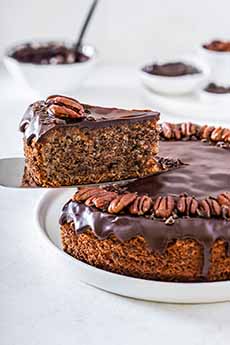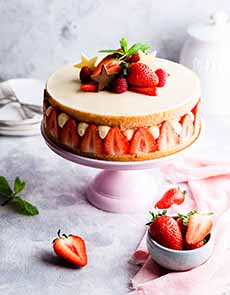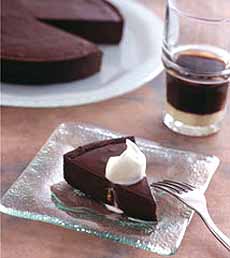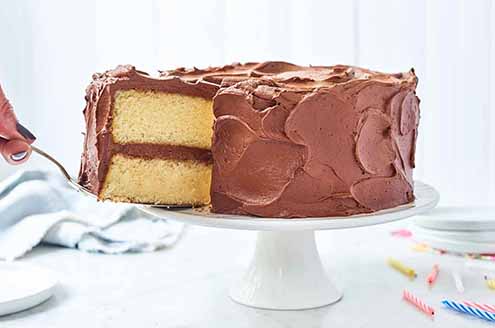|

[1] A torte is a short, dense, single-layer cake. Here’s the recipe for this beauty, a chocolate-pecan torte, which even has its own holiday: August 22nd (photo © All We Eat).

[2] An almond coconut torte: one dense layer. The recipe developer called this a cake, which is the broad category. But within the world of cake, this is a torte (photo © Food 52).

[3] This beauty is a gateaux, specifically, a frasier (French for strawberry). Here’s the recipe (photo © Anna Banana).

[4] A chocolate tart. Notice the chocolate crust around the perimeter. Here’s the recipe (photo © Pichet Ong).
|
|
Although the chocolate delight in photo #1 is baked in a rectangular tart pan, it’s a torte, not a tart.
We’ll explain the difference between cakes, tortes, tortas, and tarts.
With cakes, for example, different cooking traditions led to different styles of baking, creating cakes, gâteaux, and tortes.
All three of these are made from cake batter, with fillings and frostings as desired. There is no crust.
Let’s proceed; but first:
> The history of cake.
> The different types of cake and cake terminology: a photo glossary.
> The year’s 55 cake holidays.
CAKES, TORTES, TORTAS & TARTS: THE DIFFERENCE
Editor’s Note: Many people, including recipe authors and food writers, use the term “torte” incorrectly. We often see it ascribed to fancy layer cakes.
To be accurate, here’s the scoop.
Torte is the German word for cake (photos #1 and #2). Tortes are generally shorter and wider than cakes, and one layer. They are often unfrosted, topped with a sprinkling of confectioner’s sugar (photo #2). A torte is usually 10 to 12 inches in diameter compared to the typical 8-to-9-inch cake. That’s to compensate for the short single layer, so each short wedge will be a good portion. The Italian torta is the same concept.
The single torte layer is often no more than 2-1/2 inches high, because there’s not much, if any, flour to rise. Flourless cakes are tortes. The crumb is denser than the airy crumb of a layer cake; it’s similar to the density of a bundt cake.
Tortes are made with many eggs and little or no flour, using ground nuts (and sometimes breadcrumbs) for texture.
Since there’s an exception to every rule, the creator of the chocolate truffle torte in photo #1 elected to use a rectangular tart pan instead of a round pan.
Cake, as we know, is the English word for an umbrella category under the super-category of dessert. There are many types: cheesecake, cupcake, Bundt, layer cake (photo #5), etc. Within these categories are additional categories. To see how complex it gets, look at the *footnote.
British culinary tradition created lighter cakes like layer cakes, as well as sturdier, longer-lasting pound cakes and fruit cakes. Tortes have the richness and density of the latter.
Gâteau is the broad French term for cake or torte. It typically referrs to layered, elaborate, or decorated cakes rather than simple sponge or loaf cakes. Gâteaux are generally more delicate confections, light and rich but with fresh decorations such as fruit or whipped cream, that makes them perishable [photo #3].
The French style is layers filled with custard, whipped cream, or buttercream, the surface frosted, and decorated with fresh fruit. These ingredients make gâteaux very perishable.
British cakes, German tortes and Italian tortas are hardier creations than delicate French gâteaux.
Tart is a close relative of a pie (photo #4). Both have a crust and a filling. Pie-tart differences include:
Tart has only a bottom crust.
A tart crust is different from a pie crust. A tart crust is firm and enables the tart to stand on its own, outside of the baking pan.
A pie crust is soft and flaky. A pie needs the support of its baking pan.
The type of pan is also different: straight for a tart, sloped for a pie.
> Here’s much more on the difference between pies and tarts.

[5] “Cake” is an umbrella category with many sub-categories. This is one of the simplest, a plain layer cake. Here’s the recipe (photo © King Arthur Baking).
|
________________
*Sub-categories of layer cakes (and there are even more sub-sub-categories):
> Number of layers: single layer cake (sheet cake). two-layer-cake, multi-layer cake.
> Cake base: butter cake, chiffon cake, flourless cake, sponge /génoise.
> Filling: buttercream layer cake, custard/pastry cream layer cake, jam/preserve-filled layer cake, ganache/mousse layer cake, whipped cream with/without fruit layer cake.
> Cultural/regional style: Black Forest Cake (Germany), Japanese Strawberry Shortcake, Opera Cake (France), Red Velvet Cake (U.S.), Tres Leches Layer Cake (Latin America), Victoria Sponge (UK).
> Decoration: celebration cake (elaborate decoration), drip cake, frosted cake, naked cake.
CHECK OUT WHAT’S HAPPENING ON OUR HOME PAGE, THENIBBLE.COM.
|







